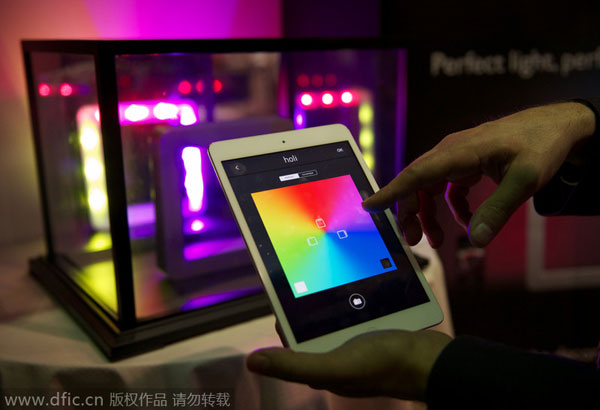10 trends within China's smartphone industry in 2015
China's smartphone market will likely see a single-digit growth in 2015 after years of fast expansion, with total sales of 450 million, according to a latest industry consultancy report.
China's smartphone market will likely see a single-digit growth in 2015 after years of fast expansion, with total sales of 450 million, according to a latest industry consultancy report.
Research firm IDC expects smartphone sales in the largest market to grow 19.9 percent year-on-year in 2014, and 7.8 percent in 2015.
"As the market reaches its capacity, it will begin to shift from new-user driven to replacement driven. That's why a single-digit growth this year is not hard to understand," said Yan Zhanmeng, senior mobile analyst at IDC China in the report.
China is expected to sell one third of world's smartphones this year, with its sales tripling the US at the second place, according to the consultancy. However, 2015 will be its first year with a single-digit growth since 2009.
Let's take a look at the 10 major trends compiled by the IDC that will likely theme China's smartphone industry in 2015.
10. Sales channels vary among different cities
Purchasing cellphone online is becoming more and more common for customers in first- and second-tier cities, where e-commerce plays a dominant role in daily sales. However, cellphone shops run by local operators are still efficient to serve vast regions among fifth- and sixth- tier cities.

A college student and part-time shop attendant recommends cellphones to customers in Wen County, Henan province, July 24, 2014. [Photo/IC]
9. Cooperation across companies more commonly seen
With technology evolving, smartphone vendors in China will face heated competitions, when teaming up to fill in shortcomings seems a likely option. As a result, an increasing number of manufacturers choose to cooperate with distributors, system suppliers, application developers, and even home appliance and auto makers.

An exhibitor demonstrates an iPhone-iPad controlled lamp, at the International Consumer Electronics Show (CES) in Las Vegas, Nevada, on Jan 5, 2014. [Photo/IC]
8. LPDDR4 will bring high-definition
The new generation internal storage technology LPDDR4, shortened for Low Power Double Data Rate 4, will make it possible to improve smartphone's screen resolution. However, due to the cost, LPDDR4 is expected to be applied to flagship phones only, and LPDDR3 will remain as mainstream in 2015.
7. Fingerprint identification technology new favorite
As more and more users manage their financial products via cellphone, it pushes mobile security to a higher standard. Fingerprint identification technology has offered a safer and more convenient solution, and therefore attracted attention from many smartphone vendors.
6. VoLTE technology will be applied to smartphones
The VoLTE technology can enable voice messages to be transmitted at a more energy-saving and stable rate. Therefore, the IDC expects network carriers and smartphone vendors to actively push forward its commercial use in China in 2015 and provide adaptability support.
5. Phablet's market share will rise to 30 percent
Thanks to a more agreeable price, phablet, also known as tablet phone, will see a rise in demand. The IDC expects its market share to grow from 18 percent last year to 30 percent in 2015. Phablets between 4 and 5.4 inches are most convenient and expected to lead the market.
4. 4G-enabled smartphone around 1,000 yuan frontrunner
Mass production of low-end chips ensures a robust market growth of smartphones below 1,000 yuan. Therefore, with carriers promoting 4G network, 4G-enabled smartphones at this price range will be the leading player in the low-end market.
For mid-end market, phone manufacturers are expected to price around 2,000 yuan and turn to advertisement and promotion for differentiation.
3. E-commerce a new force of distribution
Chinese telecom operators have been cutting down subsidies on smartphones since the second half of last year, in part to improve financial performance as the subsidies are not tax exempt. As a result, the IDC expects the market share dominated by carriers to reduce to 31 percent by the end of 2015, while e-commerce platforms will sell more than 20 percent of smartphones. Retail outlets will share the leading role in cellphone sales with online shopping sites.
2. Children and elderly increment buyers
As the authority gradually loosens one-child policy, child phones are becoming more popular, bringing increment to the market. Phone designed for elderly, on the other hand, is another niche market manufacturers plan to explore further in 2015, given the growing number of older generation.
1.Sales of 4G-enabled smartphones expected to exceed 330 million
The IDC expects sales of 4G-enabled smartphones to exceed 330 million in 2014, accounting for 71.7 percent of the market.
"As more and more chip manufacturers launch low-end products, nearly any smartphone above 700 yuan will be able to support 4G network in 2015," said Yan Zhanmeng, senior mobile analyst at IDC China.
Research firm IDC expects smartphone sales in the largest market to grow 19.9 percent year-on-year in 2014, and 7.8 percent in 2015.
"As the market reaches its capacity, it will begin to shift from new-user driven to replacement driven. That's why a single-digit growth this year is not hard to understand," said Yan Zhanmeng, senior mobile analyst at IDC China in the report.
China is expected to sell one third of world's smartphones this year, with its sales tripling the US at the second place, according to the consultancy. However, 2015 will be its first year with a single-digit growth since 2009.
Let's take a look at the 10 major trends compiled by the IDC that will likely theme China's smartphone industry in 2015.
10. Sales channels vary among different cities
Purchasing cellphone online is becoming more and more common for customers in first- and second-tier cities, where e-commerce plays a dominant role in daily sales. However, cellphone shops run by local operators are still efficient to serve vast regions among fifth- and sixth- tier cities.

A college student and part-time shop attendant recommends cellphones to customers in Wen County, Henan province, July 24, 2014. [Photo/IC]
9. Cooperation across companies more commonly seen
With technology evolving, smartphone vendors in China will face heated competitions, when teaming up to fill in shortcomings seems a likely option. As a result, an increasing number of manufacturers choose to cooperate with distributors, system suppliers, application developers, and even home appliance and auto makers.

An exhibitor demonstrates an iPhone-iPad controlled lamp, at the International Consumer Electronics Show (CES) in Las Vegas, Nevada, on Jan 5, 2014. [Photo/IC]
8. LPDDR4 will bring high-definition
The new generation internal storage technology LPDDR4, shortened for Low Power Double Data Rate 4, will make it possible to improve smartphone's screen resolution. However, due to the cost, LPDDR4 is expected to be applied to flagship phones only, and LPDDR3 will remain as mainstream in 2015.
7. Fingerprint identification technology new favorite
As more and more users manage their financial products via cellphone, it pushes mobile security to a higher standard. Fingerprint identification technology has offered a safer and more convenient solution, and therefore attracted attention from many smartphone vendors.
6. VoLTE technology will be applied to smartphones
The VoLTE technology can enable voice messages to be transmitted at a more energy-saving and stable rate. Therefore, the IDC expects network carriers and smartphone vendors to actively push forward its commercial use in China in 2015 and provide adaptability support.
5. Phablet's market share will rise to 30 percent
Thanks to a more agreeable price, phablet, also known as tablet phone, will see a rise in demand. The IDC expects its market share to grow from 18 percent last year to 30 percent in 2015. Phablets between 4 and 5.4 inches are most convenient and expected to lead the market.
4. 4G-enabled smartphone around 1,000 yuan frontrunner
Mass production of low-end chips ensures a robust market growth of smartphones below 1,000 yuan. Therefore, with carriers promoting 4G network, 4G-enabled smartphones at this price range will be the leading player in the low-end market.
For mid-end market, phone manufacturers are expected to price around 2,000 yuan and turn to advertisement and promotion for differentiation.
3. E-commerce a new force of distribution
Chinese telecom operators have been cutting down subsidies on smartphones since the second half of last year, in part to improve financial performance as the subsidies are not tax exempt. As a result, the IDC expects the market share dominated by carriers to reduce to 31 percent by the end of 2015, while e-commerce platforms will sell more than 20 percent of smartphones. Retail outlets will share the leading role in cellphone sales with online shopping sites.
2. Children and elderly increment buyers
As the authority gradually loosens one-child policy, child phones are becoming more popular, bringing increment to the market. Phone designed for elderly, on the other hand, is another niche market manufacturers plan to explore further in 2015, given the growing number of older generation.
1.Sales of 4G-enabled smartphones expected to exceed 330 million
The IDC expects sales of 4G-enabled smartphones to exceed 330 million in 2014, accounting for 71.7 percent of the market.
"As more and more chip manufacturers launch low-end products, nearly any smartphone above 700 yuan will be able to support 4G network in 2015," said Yan Zhanmeng, senior mobile analyst at IDC China.








